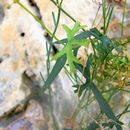Description
provided by Phytokeys
Slender, low-climbing or scrambling, perennial vine 1 m long or more, densely pubescent with unicellular curved trichomes on petiole, and adaxial leaf surface, 0.21–0.38 mm long, 0.02 mm wide, also minutely antrorsely appressed-puberulent throughout with unicellular, curved trichomes, 0.01–0.29 mm long, 0.02–0.07 mm wide. Flowering stems 0.5–1.4 mm in diameter, terete, base somewhat woody and cork-covered. Stipules, 1.9–3.6 mm long, 0.2–0.5 mm wide, narrowly ovate, acute to attenuate, longitudinally striate-nerved; petioles 0.2–1.1 cm long, commonly bearing in the distal half, (0.36-)0.52–0.81 of the distance from the base toward the apex of the petiole, 2, elliptic, opposite, sessile, cup-shaped nectaries with raised rims, 0.8–2.2 mm wide (on the widest axis), 0.2–1.3 mm high. Laminas 0.3–3.7 cm long, 3.0–14.8 cm wide, coriaceous, occasionally variegated as juveniles, 3- to 5-lobed 0.37–0.90 of the distance to the leaf base at the deepest sinus, lateral lobes 0.3–7.0 cm long, 0.1–0.6 cm wide, linear to narrowly ovate, acute to attenuate, often the primary lateral lobes with 1 to 4 smaller lobes, central lobes 0.3–3.7 cm long, 0.1–3.0 cm wide, ovate to oblong, acute to obtuse, often with 2 to 3 smaller lobes toward apex, angle between the lateral lobes 145–343°, ratio of lateral to central lobe lengths 0.58–23.33, margins entire, hyaline, primary veins 3 to 5, diverging and branching at base, laminar nectaries absent or with one submarginal nectary associated with the minor veins of the abaxial surface, 0.6–0.9 mm in diameter, circular to widely elliptic, sessile; tendril 0.1–0.5 mm wide, present at flowering node. Flowers borne in leaf axils. Pedicels 1.3–8.5 mm long, 0.4–0.6 mm wide, paired in the leaf axils; bract(s) absent or rarely with one narrowly ovate, attenuate, bract present on the distal tip of the pedicel, ca. 0.8 mm long, 0.3 mm wide; spur(s) absent. Flowers 12.8–20.6 mm in diameter with stipe 1.1–4.1 mm long, 0.6–0.8 mm wide; hypanthium 4.3–5.9 mm in diameter; sepals 3.9–8.1 mm long, 1.7–4.3 mm wide, ovate-triangular, acute to rounded, abaxially and adaxially greenish yellow; coronal filaments in 2 series, the outer 35–47, 2.7–4.9 mm long, 0.2–0.5 mm wide, linear, tapering to a point or slightly capitellate, reflexed above middle and the tips often slightly incurved, greenish yellow toward the base and yellow toward the tip or reddish purple (5RP 3/4) at the base and yellow toward the tip, ratio of outer coronal row to sepal length 0.44–0.90, the inner 35–50, 1.6–3.1 mm long, 0.1–0.3 mm wide, linear, capitate, greenish yellow with yellow tips or reddish purple with yellow tips, erect, ratio of inner coronal row to outer coronal row length 0.46–0.68; operculum 0.9–1.3 mm long, plicate, greenish yellow with yellow margin or reddish purple with yellow margin, the margin with narrow minutely fimbrillate teeth; nectary 0.1–1.0 mm high, 0.4–0.7 mm wide, slightly sulcate; limen recurved, 0.1–0.7 mm high, 0.2–1.1 mm wide, greenish yellow with a white margin or reddish purple with a white margin, limen floor 1.1–2.9 mm in diameter, greenish yellow or greenish yellow with reddish purple spots and streaks; androgynophore 2.9–4.2 mm long, 0.8–1.2 mm wide, greenish yellow or greenish yellow with reddish purple spots and streaks; free portions of the staminal filaments 1.9–3.6 mm long, 0.3–0.7 mm wide, linear, greenish yellow; anthers 1.7–2.9 mm long, 0.5–1.9 mm wide; styles 2.5–4.0 mm long including stigmas, 0.2–0.5 mm wide, greenish yellow; stigmas 0.6–1.0 mm in diameter; ovary 1.0–2.6 mm long, 0.9–2.4 mm wide, globose to slightly obovoid, greenish yellow. Berry 7.1–14.6 mm long, 7.3–15.3 mm in diameter, ovoid to obovoid, very dark purple. Seeds 12–25, 4.1–4.8 mm long, 1.9–2.5 mm wide, 1.3–1.5 mm thick, obovate in outline, acute at both ends, reticulate-foveate with each face marked with ca. 17–25 foveae.
- license
- cc-by-3.0
- copyright
- Kristen Porter-Utley
- bibliographic citation
- Porter-Utley K (2014) A revision of Passiflora L. subgenus Decaloba (DC.) Rchb. supersection Cieca (Medik.) J. M. MacDougal & Feuillet (Passifloraceae) PhytoKeys (43): 1–224
- author
- Kristen Porter-Utley
Distribution
provided by Phytokeys
Northern Mexico and southern Texas in the United States. Arid and semiarid thorn scrub (e.g., Mesquite-Black brush, Opuntia-Prosopis scrub, Tamaulipan thorn scrub) and grasslands; climbing on shrubs or scrambling on limestone outcrops and hills, or in open grassy areas on very limited to moderately developed soils; ca. 150–1500 m.
- license
- cc-by-3.0
- copyright
- Kristen Porter-Utley
- bibliographic citation
- Porter-Utley K (2014) A revision of Passiflora L. subgenus Decaloba (DC.) Rchb. supersection Cieca (Medik.) J. M. MacDougal & Feuillet (Passifloraceae) PhytoKeys (43): 1–224
- author
- Kristen Porter-Utley

